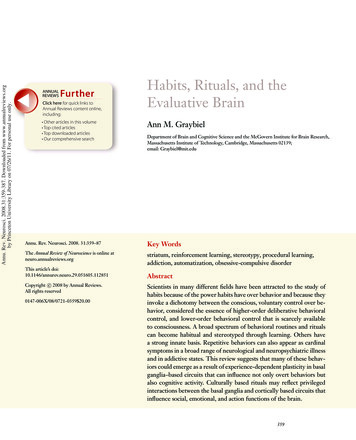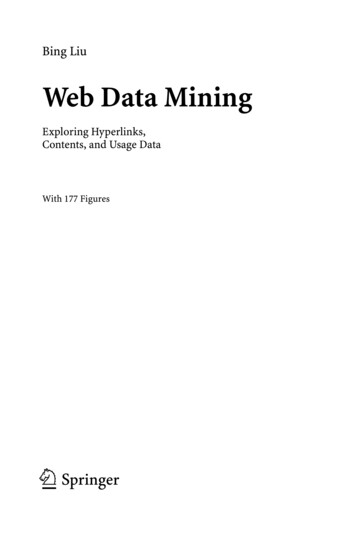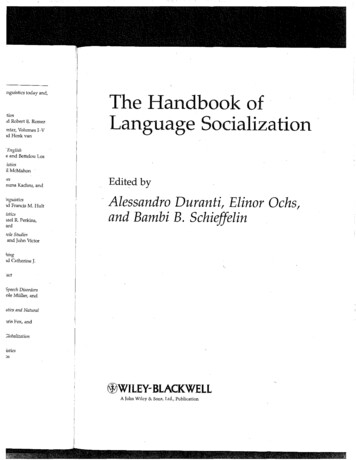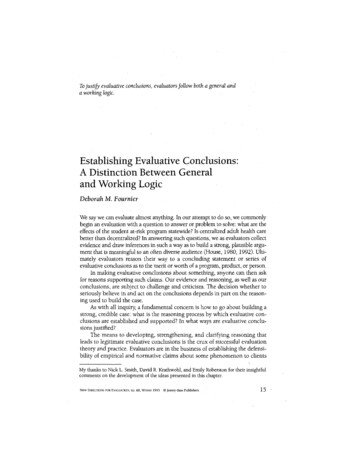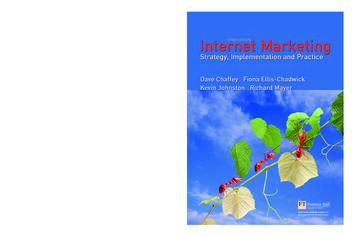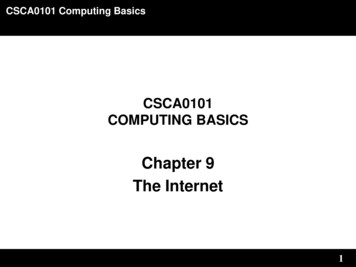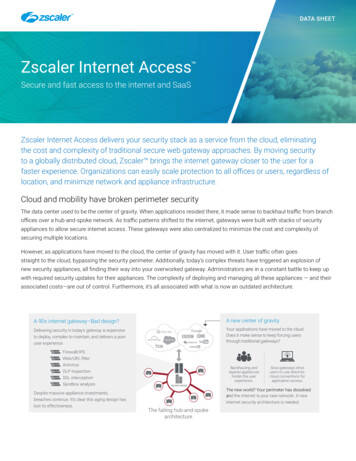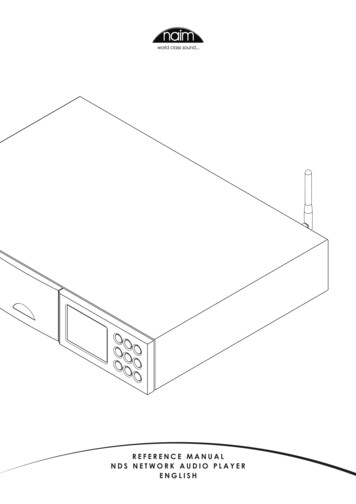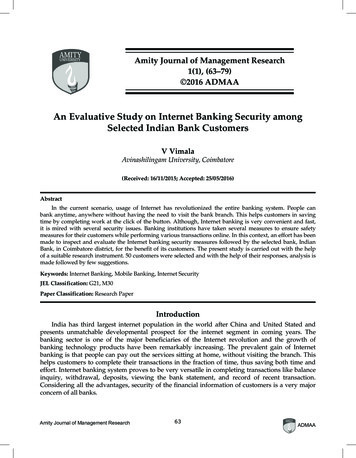
Transcription
Volume 1 Issue 1 2016AJMRAmity Journal of Management Research1(1), (63–79) 2016 ADMAAAn Evaluative Study on Internet Banking Security amongSelected Indian Bank CustomersV VimalaAvinashilingam University, Coimbatore(Received: 16/11/2015; Accepted: 25/05/2016)AbstractIn the current scenario, usage of Internet has revolutionized the entire banking system. People canbank anytime, anywhere without having the need to visit the bank branch. This helps customers in savingtime by completing work at the click of the button. Although, Internet banking is very convenient and fast,it is mired with several security issues. Banking institutions have taken several measures to ensure safetymeasures for their customers while performing various transactions online. In this context, an effort has beenmade to inspect and evaluate the Internet banking security measures followed by the selected bank, IndianBank, in Coimbatore district, for the benefit of its customers. The present study is carried out with the helpof a suitable research instrument. 50 customers were selected and with the help of their responses, analysis ismade followed by few suggestions.Keywords: Internet Banking, Mobile Banking, Internet SecurityJEL Classification: G21, M30Paper Classification: Research PaperIntroductionIndia has third largest internet population in the world after China and United Stated andpresents unmatchable developmental prospect for the internet segment in coming years. Thebanking sector is one of the major beneficiaries of the Internet revolution and the growth ofbanking technology products have been remarkably increasing. The prevalent gain of Internetbanking is that people can pay out the services sitting at home, without visiting the branch. Thishelps customers to complete their transactions in the fraction of time, thus saving both time andeffort. Internet banking system proves to be very versatile in completing transactions like balanceinquiry, withdrawal, deposits, viewing the bank statement, and record of recent transaction.Considering all the advantages, security of the financial information of customers is a very majorconcern of all banks.Amity Journal of Management Research63ADMAA
AJMRVolume 1 Issue 1 2016Review of LiteratureSeveral studies bring out the importance of security in Internet banking. Broderick andVicharapornpuk (2002) studied the importance of customer role in designing and providingquality service in Internet banking. Guraau (2002) analyzed the state of affairs of online bankingand its services. The study also pays attention more towards the virtual banking system.Karjaluoto, Mattila, and Pento (2002) made an attempt to determine those factors that influencethe formation of consumer attitude toward electronic banking. Hutchinson and Warren (2003)studied the financial service of electronic commerce, Internet Banking and its benefits to thecustomers. In the study, internet banking security measures and various techniques for privacy ofcustomers’ data has been discussed. Rotchanakitumnuai and Speece (2003) in their research workfound that corporate customers do not accept electronic form of banking, which can assist banksto implement this self-service technology more efficiently in the various banking transactions.Lympero and Chaniotakir (2004) evaluated the allusion of Internet – banking technology and theexistence of different distinct factors which affect the market. Li and Worington (2004) in theirworking paper described linkage between internet banking and electronic activities in the businessand industrial events.Pikkarainen, Pikkarainen, Karjaluoto, and Pahnila, (2004) highlighted that electronicbanking know-how had created newer usages of banking especially via online banking directmethodology. The authors adopted technology approval model to control the online environment.Singh (2004) in his study examined the collision of online banking and internet banking trends.The study also concentrated on the latest banking technology products and services for theeconomic growth. Gupta (2006) in his study analyzed the potential of Internet banking and foundthat its capability to reach each and every cranny and gap of the world holds great significancefor a realm like India. Flavián, Guinalíu, and Torres (2006) explored how customers’ sensitivity ofconventional bank guided them to take up the services of the internet. The researchers found thatif the customer trusted the traditional bank then it was feasible that they feel more forced to usethe online services offered by the same bank. Lichtenstein and Williamson (2006) explained thefactors that influence the consumer decision, to choose internet banking services in the Australiancontext. Ndubisi and Sinti (2006) discussed the impact of internet banking on customers’ stance,their needs and activities. The intent of the study was to see the internet banking adoption inMalaysia.Abu-Shanab and Pearson (2007) investigated the key determinants of the adoption of internetbanking in Jordan. Kamakodi and Khan (2008) found an exemplar shift in the Indian bankingservices in about 15 years since the Indian banking sector was liberalized. Uppal (2008) describedthat the Post – LPG (liberalization, privatization and globalization) era and information technology(IT) era, revolutionalized the face of Indian banking, as banks are stepping towards e-bankingfrom traditional banking. Lifen, Zhao, Koenig‐Lewis, Hanmer‐Lloyd, and Ward (2010) in theirstudy explained the roles of reliance and perceived the risk on client’s/customer’s usage purpose.Khare (2010) in his study described the importance of technology in civilizing customer servicelevels in being used deliberately and progressively more by service organizations.There are substantial amount of studies conducted at the Indian level and international levelbut, very few works have focused on the Internet banking, its usage, safety measures and itsperceptions, attentiveness level, satisfaction levels, attitudes and behavior of the internet banking,security issues, and financial frauds Additionally, studies relating to the Internet banking securityspecifically in the Southern Region of Tamil Nadu are extremely limited. The present study isan attempt to bridge this research gap by studying Internet banking security among the selectedIndian Bank customers.ADMAA64Amity Journal of Management Research
Volume 1 Issue 1 2016AJMRStatement of ProblemIn the present state of affairs, the banking sector has been seen a mammoth progress and thepopularity with respect to the Internet banking services and its products. This development hasled to the large number of internet banking transactions, which are faster and more convenientmode of transactions, for the bank customers. Banking industry is one of the businesses thathave used the full potential of IT to help with banking transactions and increase banking servicesand opportunities to its customers. These facilities helped millions of customers to perform theirtransaction anytime anywhere easily, quickly and smoothly with perfections. However to carryout banking transactions through the Internet, one needs to have some basic knowledge aboutcomputers and the Internet, which to some extent, limits the number of people willing to avail thisfacility. Many people who are not comfortable with computers and the Internet find it difficult touse this service.Objectives of the StudyThe central objectives of the present study are 1.To analyze the customers’ perceptions and awareness towards Internet banking security;2.To understand the problems faced by customers while using internet banking services; and3.To know impact of the internet banking securities among the selected customers in Coimbatore.Scope of the StudyThis study provides a guide to the current structure of the Internet banking security andhighlights awareness level of customers for using Internet banking, and their perception andsatisfaction towards Internet banking with new technologies and its functioning. This helps toknow in details about development in banking industry with advancement in technology. It alsohelps in understanding different services offered in Internet banking. Ultimately this would helpin understanding the benefits of Internet banking to customers as well as banking industry.Research MethodologySample DesignThe multi-stage sampling technique was adopted for selection of respondents for the study.The customers of Indian Bank, ADU Campus, and Coimbatore were selected in four stages. Thereare about 1647 Indian Bank branches in India, out of which 710 Indian Bank branches are inTamilnadu, 37 Indian Bank branches are in Coimbatore, out of the 37 Indian Bank branches, onlyADU Campus (Avinashilingam Institute for Home Science and Higher Education for Women) waspurposively selected for the study. Sampling Size - In the present study, 50 customers were takenas sample size.Type of Study and DataThe present study is analytical and exploratory in nature. Accordingly, the data used isboth primary as well as secondary. The relevant reports viz., RBI monthly bulletins, Magazines,newspapers, business dailies, books and journals, e-media and other literature available in thisfield constitute secondary sources for the present study. The awareness of, perception towards,satisfaction of Internet banking security is studied with the help of a structured questionnaire. TheAmity Journal of Management Research65ADMAA
AJMRVolume 1 Issue 1 2016primary data has been collected, through a separate pre-tested Questionnaire from 50 Internetbanking customers, in Tamil Nadu division of Coimbatore. The Internet banking users wereselected from ADUC Branch, Coimbatore.Statistical Tools and TechniquesTo analyze the collected data, various statistical techniques and tools such as averages,frequency distribution tables, and normal distribution were used. The study also uses othersuitable statistical tools such as mean, median, standard deviation with co-efficient of variation,correlation and regression, factor analysis etc. SPSS software package and the IBM – AMOS 20.0version software were used for the analysis.Hypothesis of the StudyThe major hypotheses of the study are as follows:H01: Internet banking has no significant relationship with traditional banking system.H02: Internet banking security has no significant impact on the customersAnalysis and InterpretationsTable 1: Socio-Economic Profile of Internet banking customers, CoimbatoreS. No.01.CategoryAge31-4041-5051-6060 and e03.25501530010250100Male29-2958-212142292150100Up to yee in Public Sector05010612Employee in Private Sector08081632Student02050714Retired 1TOTAL04.(%) ofRespondents-TOTALQualificationPUCGraduatePost GraduateProfessional DegreeNo. Continued.)ADMAA66Amity Journal of Management Research
Volume 1 Issue 1 201605.AJMRMonthlyIncomeBelow ,000-1,00,00001-01021,00,000 and 292150100Up To 3070512244-6211435706 and rs07.TOTALType OfAccount08.292150100Savings A/C17193672Current A/c12021428292150100TOTALTable 1 above shows the socio-economic profile of the selected Internet banking users inCoimbatore. 50% of the customers in the age group of 20 – 30 in Coimbatore district use Internetbanking. Out of this, 58% are males. It also clear that graduates are more likely to use Internetbanking; 32% of customers of Internet banking work in private organizations. 34% of Internetbanking users is from middle income group. Majority of Internet Banking Users are Single at 54%and 72% of savings account holders in the bank use Internet banking facilities.Table 2: Internet Banking Awareness Level of Indian Bank Customers, CoimbatoreS.No.Become Awarethrough variousModesNo. of RespondentsPercentage ofRespondents01.Advertisement163202.News on051006.Friends061207.Bankers0918TOTAL50100Table 2 indicates that Internet banking awareness level of Indian Bank customers, Coimbatore.It shows that 32% of the people were aware about Internet banking facility through advertisement;it also reveals that 18% of the people in Coimbatore are aware of Internet banking throughbankers. 8% of the customers become aware of Internet banking through newspapers and parentalinfluence; 12% become aware because of relatives and friends; and 10% through television.Amity Journal of Management Research67ADMAA
AJMRVolume 1 Issue 1 2016Table 3: Awareness Level of Internet Banking Security among the Selected Customers ofIndian Bank, ADU CampusSl.No.Types of Security /Protection Mode01.SAANDSDNo%No%No%No%No%Security Code1938214205100306020402.Password protection2346214205100102000003.Transaction 122407141530102005.Authentication Security0408091810201632112206.Hardware Security0510091808161428142807.Database Security0918163202041224112208.Memory Protection0714204004081326061209.File Security10202244061205100714(Note: SA – Strongly Agree, A – Agree, N – Neutral, D – Disagree, SD – Strongly Disagree)Table 3 indicates the awareness level of Internet banking security among the selectedcustomers in ADU campus. It is reveals that 42% of respondents are aware of security code forusing Internet banking; 46% of the respondents are aware of password protection; 40% are awareof transaction security; 24% of the people are aware of confidentiality security; 18% are awareof hardware security; 32% of the respondents are aware of database security; 40% are aware ofmemory protection; and 44% of respondents are aware of file security. It shows that maximumcustomers are aware of password protection security.Table 4: Benefits of Traditional Banking SystemS. No.Banking Services / Facilities1.2.3.SAANDSDNo%No%No%No%No%Interaction with Banker07142142020418360204Easy Deposit and Withdrawal03061224040822440918Collection Of Cheque081622440102132606124.Demand 801026.Security Lockers17342040020406120510Table 4 indicates that benefits of traditional banking system. It is reveals that 42% of therespondents agree with the benefits of interaction with banker; 44% of the respondents disagreewith the benefits of easy deposit and withdrawal; 44% of the respondents agree with the benefitsof collection of cheque; 50% of the respondents agree with the benefits of demand draft; 64% ofthe people agree the benefits of security; and 40% of the respondents agree with the benefits ofADMAA68Amity Journal of Management Research
Volume 1 Issue 1 2016AJMRsecurity lockers. It is observed that maximum people benefitted from the secure traditionalbanking.Table 5: Benefits of Internet Banking SystemS. No.Internet BankingBenefitsSANoA%NoN%DNo%NoSD%No%1.Time Saving47940306------2.Any Time Banking41820918------3.Any Where Banking397809180204----4.Easy Accessibility387610200204----5.No Queue14283672------6.Ease of Monitoring0510336609180306--7.Friendlier Rates05101122081625500102(Note: SA – Strongly Agree, A – Agree, N – Neutral, D – Disagree, SD – Strongly Disagree)Table 5 indicates benefits of Internet banking system. It is reveals that 94% of the respondentsstrongly agree with the benefits of time saving; 82% of the respondents strongly agree with thebenefits of any time banking; 78% of the respondents strongly agree with the benefits of anywherebanking; 76% of the respondents strongly agree with the benefits of easy accessibility; 72% of therespondents agree with the benefits of no queue; 66% of the respondents agree with the benefitsof ease of monitoring; and 50% of the respondents disagree the benefits of friendlier rates. It isobserved that maximum respondents benefited due to time saving through Internet banking.Table 6: Usage of Internet Banking ServicesS. No.Usage of Internet Banking Secured Transaction2.Quick Settlement214228560102----3.Electronic Fund Transfer1326336602040204--4.Electronic Clearing Services1224316203060408--5.Electronic Payment Services112222440204112204086.National Electronic Fund Transfer163224480408030603067.Real Time Gross Settlement112225500612040804088.Core Banking System03061326020417341530(Note: SA - Strongly Agree, A - Agree, N - Neutral, D-Disagree, SD – Strongly Disagree)Table 6 indicates the usage of Internet banking services. It observes 50% of respondentsdisagree with the usage of secured transaction; 56% of respondents agree with the usage ofAmity Journal of Management Research69ADMAA
AJMRVolume 1 Issue 1 2016quick settlement; 66% of respondents agree with the usage of electronic fund transfer; 62% ofrespondents agree the usage of electronic clearing services (ECS); 44% of respondents agree theusage of electronic payment service; 48% of respondents agree the usage of national electronicfund transfer; 50% of respondents agree with the usage of real time gross settlement (RTGS); 34%of respondents disagree with the core banking system. It is concluded that maximum respondentsaccepted the usage of electronic fund transfer.Table 7: Factors Influencing the Internet Banking FacilityS. 3860714------2.Friends / Relatives Advice31621836--0102--3.Personality of BankManager0510346807140416--4.Popularity Of Banks071436720714----5.Quality Of Service0714346806120306--(Note: SA - Strongly Agree, A - Agree, N - Neutral, D - Disagree, SD – Strongly Disagree)Table 7 shows the factors influencing the Internet banking facilities. It shows that 86% ofrespondents strongly agree with the influencing factor of convenience; 62% of respondentsstrongly agree with the factor of friends and relatives; 68% of respondents strongly agree withthe factor of personality of bank manage; 72% of respondents strongly agree with the factor ofpopularity of banks; 68% of respondents strongly agree with the factor of quality of services. It isclear that most of the respondents are influenced by the factor of convenience.Table 8: Internet Banking Users by Application of Various BrowsersS. No.Type of BrowserMPPMLPLPNAPNo%No%No%No%No%1.Internet explorer020403060510336607142.Google Chrome051028560306122402043.Mozilla 3774(Note: MP - Most Preferred, P – Preferred, MLP – Most Likely to Preferred, LP – Least Preferred, NAP – Not At All Preferred)Table 8 indicates various browsers used by internet banking customers. It shows that theleast preferred browser was Internet Explorer with 66% not preferring it. 56% of the respondentspreferred the Google chrome; whereas 82% of the respondents most preferred the Mozilla Firebox;Opera and Netscape were the least preferred browsers, whereas Safari was not preferred at all. Itis clear that most preferred browser for Internet banking was Mozilla Firefox.ADMAA70Amity Journal of Management Research
Volume 1 Issue 1 2016AJMRTable 9: Operating System Used for the Internet Banking Transaction and SecurityS. No.MPType of Operating 4010201022.Window81122285601021020--3.Linux Mint040813260510255003064.Linux Live buntu (Operating system for Desktop)020401020306316213267.Windows XP Professional112228560306061202048.Macintosh OSX------255025509.Windows 8.10306091802041632204010.Windows Android05100408102015301632(Note: MP – Most Preferred, P – Preferred, MLP – Most Likely to Preferred, LP –Least Preferred, NAP – Not At All Preferred)Table 9 indicates the various operating systems of Internet banking transaction and security.It shows that 58% of respondents prefer to use Windows 7 and 56% of respondents prefer to useWindows 8. It was found that Linux Live CD, Mac, Macintosh OSX, Android and Windows 8.1operating systems were not at all preferred by the respondents; including Linux Mint, Ubuntu andFedora, which were least preferred. 72% of the respondents most preferred to use Windows XP. Itis clear most of the respondents preferred to use windows XP.Table 10: Operating System updating and Security PatchesS. No.CategoryGenderMaleFemaleNo. ofRespondentsPercentage(In %)1.Yes201535702.No070411223.Can’t say020248292150100TotalTable 10 indicates updating and security patches of operating system. It is reveals that 70% ofthe respondents are aware of updating with security patches. However, 22% of the respondentsare not aware of the same.Table 11: Anti-Malware Preference tools for using Internet Banking SecurityMPPMLPLPNAPS. No.Type of y Journal of Management Research71ADMAA
AJMRVolume 1 Issue 1 20163.Anti – Spyware081607140510102020404.Spyware Blaster071403060204204018365.AVG Anti Root kit010204080102091835706.Comodo Firewall Pro020405102040--23467.Windows Defender--06120306193822448.Malicious Software040806121020193811229.McAfee Virus0510112201021938142810.Microsoft Security05100918071411221836(Notes: MP - Most Preferred, P – Preferred, MLP – Most Likely to Preferred, LP –Least Preferred, NAP – Not At All Preferred)Table 11 indicates the various anti-malware tools of Internet banking security. It shows that36% of the respondents prefer to use anti – virus and 54% of the respondents prefer to use firewall.It was founds that respondents least preferred to use Spyware Blaster and not at all preferredto use AVG anti-root kit, Comodo Firewall and Windows Defender. It is clear that most of therespondents prefer to use some type of firewall.Table 12: Frequency of Internet Banking TransactionS. No.CategoryNo. of respondentsPercentage (in ery Often010250100TotalTable 12 indicates that frequency Internet banking transactions. It shows that, 26% of therespondents occasionally use the Internet banking; 66% of the respondents frequently usethe Internet Banking; 6% of the respondents never using the Internet Banking; and 2% of therespondents very often to use Internet Banking.Table 13: Frequency of changes in the Internet banking passwordS. No.CategoryNo. of respondentsPercentage (%)1.Monthly22442.Quarterly15303.Half Yearly11224.Yearly0204Total50100Table 13 indicates frequency of changes in the Internet banking password. It shows that 44%of the respondents change their password monthly; 30% of the respondents change passwordsquarterly; 22% of the respondents change passwords half yearly; 4% of the respondents changepasswords on yearly basis. It is concluded that maximum respondents changing our password inmonthly basis.ADMAA72Amity Journal of Management Research
Volume 1 Issue 1 2016AJMRTable 14: Purpose for Using Internet Banking Services among the Selected CustomerS. No.SADescriptionANDSDNo%No%No%No%No%1.Online Ticket Booking377411220204----2.Online Bill Payment3774091803060102--3.Balance Enquiry367211220306----4.Request for Cheque Book020406120918183615305.Income Tax/TDS Payment091822440714102002046.Service Tax/Central Excise112217340714132602047.Insurance Premium Payment020411220612234608168.Online Shares Trading091810200714153009189.TNEB Payments2754153004080408--10.Online Shopping28561938--0306--(Note: SA – Strongly Agree, A – Agree, N – Neutral, D – Disagree, SD – Strongly Disagree)Table 14 indicates the purpose for using Internet banking services. It shows that 74% of therespondents use Internet banking for online ticket booking; 74% of the respondents use Internetbanking for online bill payment; 72% for balance enquiry; 44% for Income Tax Payment; 54% forTNBE Payments; and 56% for online shopping. It was also found that respondents do not useInternet banking for insurance premium payment and online shares trading. It is observed thatmaximum respondents use Internet banking for online ticket booking and online bill payment.Table 15: Technical Problems and Difficulties While Using Internet Banking FacilityS. No.DescriptionSAANDSDNo%No%No%No%No%1.Hacking 30604083.Malware122419380612071406124.Illegal Activities040813260816142811225.Transaction Activities05101122010208162550(Note: SA – Strongly Agree, A – Agree, N – Neutral, D – Disagree, SD – Strongly Disagree)Table 15 indicates that technical problems and difficulties faced while using Internet banking.The fllowing are the problems faced by the respondents: 50% - hacking attacks, 50% - Phishingattacks, 38% - Malware. It is concluded that maximum respondents face the problems of hackingattacks and phishing.Amity Journal of Management Research73ADMAA
AJMRVolume 1 Issue 1 2016Testing of the HypothesisTest of Hypothesis – IH01: Internet banking has no significant relationship with traditional banking system.Table 16: Correlation between Internet Banking and Traditional 1-.334*-.136.018.347(Continued.)ADMAA74Amity Journal of Management Research
Volume 1 Issue 1 184.467.089.062.697.347.0011.445**.0011* Correlation is significant at the 0.05 level** Correlation is significant at the 0.01 level(Note: IWB – Interaction with Banker, DW – Deposit and withdrawal, CC - collection of cheque, DD – Demand Draft, SL – Safety Lockers, TM –Time Saving, ATB – Any Time Banking, AWB – Any Where Banking , EA – Easy Accessible, NQ – No Queue, EM – Ease of Monitoring, FR – FriendlierRates)The value of Pearson correlation range from -1 to 1 with negative numbers representing anegative correlation (as one variable increases, the other variable decreases) and positive numbersrepresenting a positive correlation (as one variable increases, the other also increases). The closerthe value is to -1 or 1 the stronger the association is between the variables. There is a positiverelationship between the traditional banking system and Internet banking system. The aboveresults do not show any significant association between traditional and Internet banking system.Therefore, the null hypothesis, H01, is accepted.Test of Hypothesis – IIH02: Internet banking security has no significant impact on the customersTable 17: Correlation between Internet Banking Security and its influencing on CorrelationSCG1Sig. arson Correlation-.122Sig. (2-tailed).399Pearson Correlation-.046.064Sig. (2-tailed).753.661Pearson Correlation-.052.154.064Sig. (2-tailed).722.285.661Pearson Correlation.060-.183-.144-.068Sig. (2-tailed).679.203.318.637Pearson Correlation-.045-.198-.251-.091-.166Sig. (2-tailed).758.169.079.529.248Pearson Correlation-.039-.037-.427**-.266-.055.266Sig. )Amity Journal of Management Research75ADMAA
AJMRVolume 1 Issue 1 2016MPSFSPearson Correlation-.035-.145-.015-.082-.216.072.253Sig. (2-tailed).808.314.920.573.132.622.076Pearson Correlation-.280.139.029-.207.021.076-.304Sig. -.1571.277* Correlation is significant at the 0.05 level(2 – tailed)** Correlation is significant at the 0.01 level (2 –tailed)(Note: SCG – Security Code Generators, PPS – Password Protection Security, TS – Transaction Security, CS – Confidential Security, AS –Authentication Security, HS – Hardware Security, DS – Database Security, MPS – Memory Protection Security, FS – File Security)Results from Table 17 show that there is a signifi
banking; 32% of customers of Internet banking work in private organizations. 34% of Internet banking users is from middle income group. Majority of Internet Banking Users are Single at 54% and 72% of savings account holders in the bank use Internet banking facilities. Table 2: Internet Banking Awareness Level of Indian Bank Customers, Coimbatore S.
